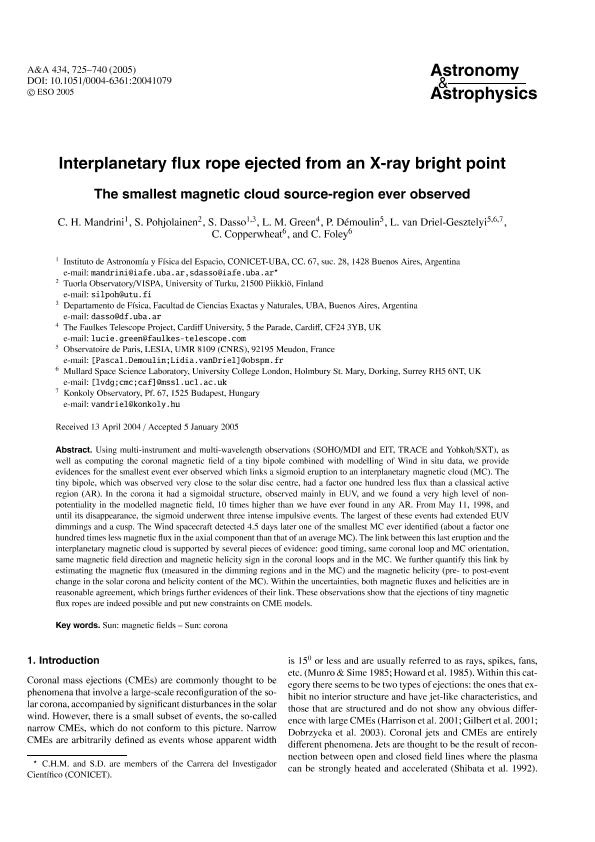Artículo
Interplanetary flux rope ejected from an X-ray bright point: The smallest magnetic cloud source-region ever observed
Mandrini, Cristina Hemilse ; Pohjolainen, S.; Dasso, Sergio Ricardo
; Pohjolainen, S.; Dasso, Sergio Ricardo ; Green, L. M.; Démoulin, Pascal; van Driel Gesztelyi, Lidia; Copperwheat, C.; Foley, C.
; Green, L. M.; Démoulin, Pascal; van Driel Gesztelyi, Lidia; Copperwheat, C.; Foley, C.
 ; Pohjolainen, S.; Dasso, Sergio Ricardo
; Pohjolainen, S.; Dasso, Sergio Ricardo ; Green, L. M.; Démoulin, Pascal; van Driel Gesztelyi, Lidia; Copperwheat, C.; Foley, C.
; Green, L. M.; Démoulin, Pascal; van Driel Gesztelyi, Lidia; Copperwheat, C.; Foley, C.
Fecha de publicación:
12/2005
Editorial:
EDP Sciences
Revista:
Astronomy and Astrophysics
ISSN:
0004-6361
Idioma:
Inglés
Tipo de recurso:
Artículo publicado
Clasificación temática:
Resumen
Using multi-instrument and multi-wavelength observations (SOHO/MDI and EIT, TRACE and Yohkoh/SXT), as well as computing the coronal magnetic field of a tiny bipole combined with modelling of Wind in situ data, we provide evidences for the smallest event ever observed which links a sigmoid eruption to an interplanetary magnetic cloud (MC). The tiny bipole, which was observed very close to the solar disc centre, had a factor one hundred less flux than a classical active region (AR). In the corona it had a sigmoidal structure, observed mainly in EUV, and we found a very high level of non-potentiality in the modelled magnetic field, 10 times higher than we have ever found in any AR. From May 11, 1998, and until its disappearance, the sigmoid underwent three intense impulsive events. The largest of these events had extended EUV dimmings and a cusp. The Wind spacecraft detected 4.5 days later one of the smallest MC ever identified (about a factor one hundred times less magnetic flux in the axial component than that of an average MC). The link between this last eruption and the interplanetary magnetic cloud is supported by several pieces of evidence: good timing, same coronal loop and MC orientation, same magnetic field direction and magnetic helicity sign in the coronal loops and in the MC. We further quantify this link by estimating the magnetic flux (measured in the dimming regions and in the MC) and the magnetic helicity (pre- to post-event change in the solar corona and helicity content of the MC). Within the uncertainties, both magnetic fluxes and helicities are in reasonable agreement, which brings further evidences of their link. These observations show that the ejections of tiny magnetic flux ropes are indeed possible and put new constraints on CME models.
Archivos asociados
Licencia
Identificadores
Colecciones
Articulos(IAFE)
Articulos de INST.DE ASTRONOMIA Y FISICA DEL ESPACIO(I)
Articulos de INST.DE ASTRONOMIA Y FISICA DEL ESPACIO(I)
Citación
Mandrini, Cristina Hemilse; Pohjolainen, S.; Dasso, Sergio Ricardo; Green, L. M.; Démoulin, Pascal; et al.; Interplanetary flux rope ejected from an X-ray bright point: The smallest magnetic cloud source-region ever observed; EDP Sciences; Astronomy and Astrophysics; 434; 2; 12-2005; 725-740
Compartir
Altmétricas



